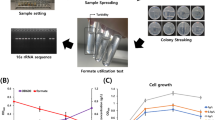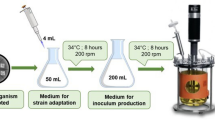Abstract
Eighteen gram-negative thermotolerant poly(3-hydroxybutyrate) (PHB)-degrading bacterial isolates (T max≈60°C) were obtained from compost. Isolates produced clearing zones on opaque PHB agar, indicating the presence of extracellular PHB depolymerases. Comparison of physiological characteristics and determination of 16S rRNA gene sequences of four selected isolates revealed a close relatedness of three isolates (SA8, SA1, and KA1) to each other and to Schlegelella thermodepolymerans and Caenibacterium thermophilum. The fourth strain, isolate KB1a, showed reduced similarities to the above-mentioned isolates and species and might represent a new species of Schlegelella. Evidence is provided that S. thermodepolymerans and C. thermophilum are only one species. The PHB depolymerase gene, phaZ, of isolate KB1a was cloned and functionally expressed in Escherichia coli. Purified PHB depolymerase was most active around pH 10 and 76°C. The DNA-deduced amino acid sequence of the mature protein (49.4 kDa) shared significant homologies to other extracellular PHB depolymerases with a domain substructure: catalytic domain type 2—linker domain fibronectin type 3—substrate-binding domain type 1. A catalytic triad consisting of S20, D104, and H138 and a pentapeptide sequence (GLS20AG) characteristic for PHB depolymerases (PHB depolymerase box, GLSXG) and for other serine hydrolases (lipase box, GXSXG) were identified.




Similar content being viewed by others
References
Altenbuchner J, Viell P, Pelletier I (1992) Positive selection vectors based on palindrome DNA sequences. Methods Enzymol 216:457–466
Braaz R, Wong S-L, Jendrossek D (2002) Production of PHA depolymerase A (PhaZ5) from Paucimonas lemoignei in Bacillus subtilis. FEMS Microbiol Lett 209:237–241
Chowdhury AA (1963) Poly-ß-hydroxybuttersäure abbauende Bakterien und Exoenzym. Arch Mikrobiol 47:167–200
Delafield FP, Doudoroff M, Palleroni NJ, Lusty CJ, Contopoulos R (1965) Decomposition of poly-β-hydroxybutyrate by pseudomonads. J Bacteriol 90:1455–1466
Doi Y, Steinbüchel A (2001) Biopolymers, vol 3A. Polyesters I—biological systems and biotechnological production. Wiley-VCH, Weinheim
Elbanna K, Lüdke-Eversloh T, van Trappen S, Mergaert J, Swings J, Steinbüchel A (2003) Schlegelella thermodepolymerans gen. nov., sp. nov., a novel thermophilic bacterium that degrades poly(3-hydroxybutyrate-co-3-mercaptopropionate). Int J Syst Evol Microbiol 53:1165–1168
Hanahan D (1983) Studies on transformation of Escherichia coli with plasmids. J Mol Biol 166:557–580
Handrick R, Reinhardt S, Focarete ML, Scandola M, Adamus G, Kowalczuk M, Jendrossek D (2001) A new type of thermoalkalophilic hydrolase of Paucimonas lemoignei with high specificity for amorphous polyesters of short-chain-length hydroxyalkanoic acids. J Biol Chem 276:36215–36224
Handrick R, Reinhardt S, Jendrossek D (2004a) Purification, characterization and cloning of the “intracellular” PHB depolymerase of Rhodospirillum rubrum: an enzyme with high similarity to extracellular PHB depolymerases. Submitted for publication
Handrick R, Reinhardt S, Schultheiss D, Reichart T, Schüler D, Jendrossek V, Jendrossek D (2004b) Unraveling of the function of the Rhodospirillum rubrum activator of polyhydroxybutyrate (PHB) degradation: the activator is a PHB granule bound protein (phasin). J Bacteriol 186:2466–2475
Haney PJ, Badger JH, Buldak GL, Reich CI, Woese CR, Olsen GJ (1999) Thermal adaptation analyzed by comparison of protein sequences from mesophilic and extremely thermophilic Methanococcus species. PNAS USA 30:3578–3583
Jendrossek D (2002) Extracellular polyhydroxyalkanoate depolymerases: the key enzymes of PHA degradation. In: Doi Y, Steinbüchel A (eds) Biopolymers, vol 3B. Wiley-VCH, Weinheim, pp 47–77
Jendrossek D, Handrick R (2002) Microbial degradation of polyhydroxyalkanoates. Annu Rev Microbiol 56:403–432
Jendrossek D, Knoke I, Habibian RB, Steinbüchel A, Schlegel HG (1993a) Degradation of poly(3-hydroxybutyrate), PHB, by bacteria and purification of a novel PHB depolymerase from Comamonas sp. J Environ Polym Degrad 1:53–63
Jendrossek D, Müller B, Schlegel HG (1993b) Cloning and characterization of the poly(hydroxyalkanoic acid)-depolymerase gene locus, phaZ1, of Pseudomonas lemoignei and its gene product. Eur J Biochem 218:701–710
Jendrossek D, Backhaus M, Andermann M (1995a) Characterization of the extracellular poly(3-hydroxybutyrate) depolymerase of Comamonas sp. and of its structural gene. Can J Microbiol 41(Suppl 1):160–169
Jendrossek D, Frisse A, Behrends A, Andermann M, Kratzin HD, Stanislawski T, Schlegel HG (1995b) Biochemical and molecular characterization of the Pseudomonas lemoignei depolymerase system. J Bacteriol 177:596–607
Madison LL, Huisman GW (1999) Metabolic engineering of poly(3-hydroxyalkanoates): from DNA to plastic. Microbiol Mol Biol Rev 63:21–53
Manaia CM, Nunes OC, Nogales B (2003) Caenibacterium thermophilum gen. nov., sp. nov., isolated from a thermophilic aerobic digester of municipal sludge. Int J Syst Evol Microbiol 53:1375–1382
Mergaert J, Swings J (1996) Biodiversity of microorganism that degrade bacterial and synthetic polyesters. J Ind Microbiol 17:463–469
Merrick JM, Doudoroff M (1964) Depolymerization of poly-β-hydroxybutyrate by an intracellular enzyme system. J Bacteriol 88:60–71
Neumeier S (1994) Abbau thermoplastischer Biopolymere auf Poly-ß-Hydroxyalkanoat-Basis durch terrestrische and marine Pilze. Diploma thesis. Universität Regensburg
Nojiri M, Saito T (1997) Structure and function of poly(3-hydroxybutyrate) depolymerases from Alcaligenes faecalis T1. J Bacteriol 179:6965–6970
Schirmer A, Matz C, Jendrossek D (1995) Substrate specificities of PHA-degrading bacteria and active site studies on the extracellular poly(3-hydroxyoctanoic acid) [P(3HO)] depolymerase of Pseudomonas fluorescens GK13. Can J Microbiol 41(Suppl 1):170–179
Shinohe T, Nojiri M, Saito T, Stanislawski T, Jendrossek D (1996) Determination of the active sites of the poly(3-hydroxybutyrate) depolymerase of Pseudomonas lemoignei (PhaZ5) and of Alcaligenes faecalis. FEMS Microbiol Lett 141:103–109
Stinson MW, Merrick JM (1974) Extracellular enzyme secretion by Pseudomonas lemoignei. J Bacteriol 119:152–161
Takeda M, Koizumi J, Yabe K, Adachi K (1998) Thermostable poly(3-hydroxybutyrate) depolymerase of a thermophilic strain of Leptothrix sp. isolated from a hot spring. J Biosci Bioeng 85:375–380
Takeda M, Kitashima K, Adachi K, Hanaoka Y, Suzuki I, Koizumi J (2000) Cloning and expression of the gene encoding thermostable poly(3-hydroxybutyrate) depolymerase. J Biosci Bioeng 90:416–421
Takeda M, Kamagata Y, Ghiorse WC, Hanada S, Koizumi J (2002) Caldimonas manganoxidans gen. nov., sp. nov., a poly(3-hydroxybutyrate)-degrading manganese-oxidizing thermophile. Int J Syst Evol Microbiol 52:895–900
Tanio T, Fukui T, Shirakura Y, Saito T, Tomita K, Kaiho T (1982) An extracellular poly(3-hydroxybutyrate) depolymerase from Alcaligenes faecalis. Eur J Biochem 124:71–77
Yu Z, Mohn MM (1999) Isolation and characterization of thermophilic bacteria capable of degrading dehydroabietic acid. Can J Microbiol 45:513–519
Acknowledgments
This work was supported by the Deutsche Forschungsgemeinschaft. We thank Beate Müller (Umwelt Schutz Nord) for providing compost samples. Advice of the Deutsche Sammlung für Mikroorganismen und Zellkulturen (DSMZ) is greatfully acknowledged.
Author information
Authors and Affiliations
Corresponding author
Additional information
This contribution is dedicated to Hans G. Schlegel in honor of his 80th birthday.
Fabian Romen and Simone Reinhardt share first authorship.
Rights and permissions
About this article
Cite this article
Romen, F., Reinhardt, S. & Jendrossek, D. Thermotolerant poly(3-hydroxybutyrate)-degrading bacteria from hot compost and characterization of the PHB depolymerase of Schlegelella sp. KB1a. Arch Microbiol 182, 157–164 (2004). https://doi.org/10.1007/s00203-004-0684-2
Received:
Revised:
Accepted:
Published:
Issue Date:
DOI: https://doi.org/10.1007/s00203-004-0684-2




